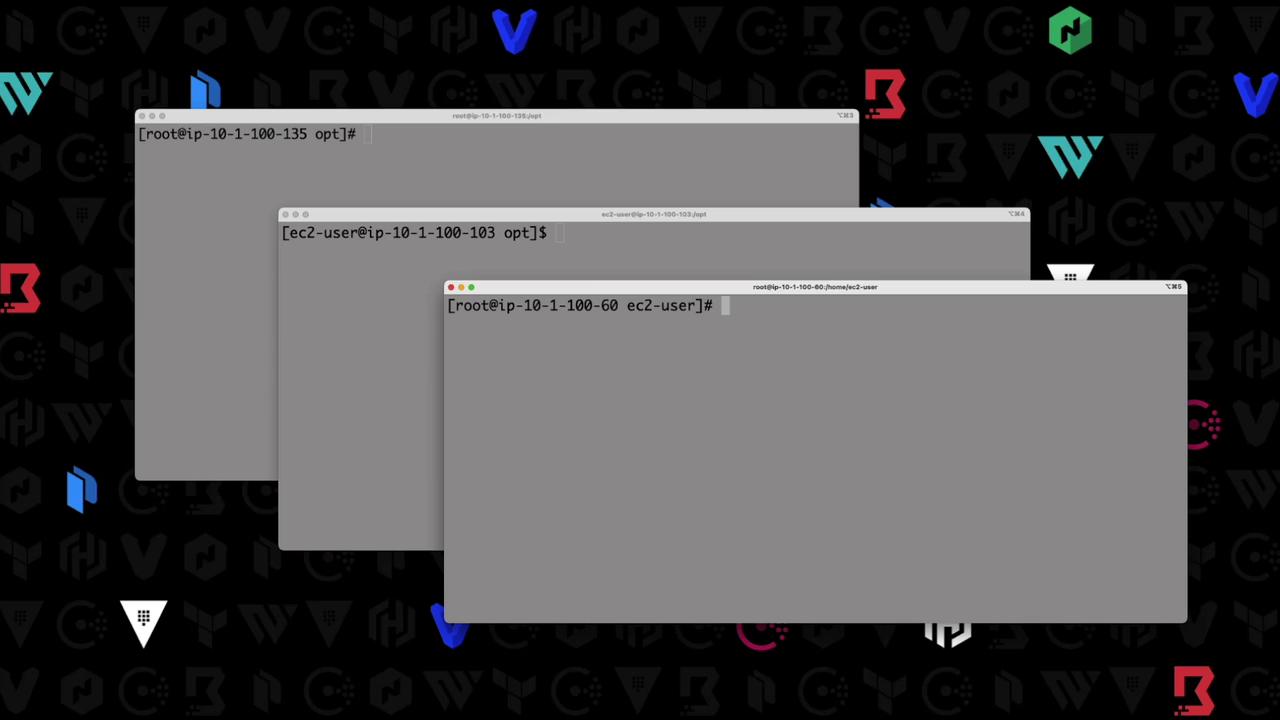HashiCorp Certified: Vault Operations Professional 2022
Create a working Vault server configuration given a scenario
Demo Integrated Storage
In this walkthrough, you’ll configure three Vault Enterprise nodes on AWS to form a highly available (HA) Raft cluster with AWS KMS auto-unseal. We’ll cover node setup, initialization, joining new nodes, leadership management, and automated cluster joining.

1. Node Configuration
Each node runs an almost identical vault.hcl. The only differences are the node_id, api_addr, and cluster_addr.
storage "raft" {
path = "/opt/vault"
node_id = "vault-1"
}
listener "tcp" {
address = "0.0.0.0:8200"
cluster_address = "0.0.0.0:8201"
tls_disable = true
}
seal "awskms" {
region = "us-east-1"
kms_key_id = "arn:aws:kms:us-east-1:003674902126:key/8bc6b2ab-840a-4eef-8f2d-5616a3e67900"
}
api_addr = "http://10.1.100.135:8200"
cluster_addr = "http://10.1.100.135:8201"
cluster_name = "vault"
ui = true
log_level = "INFO"
license_path = "/etc/vault.d/vault.hcl"
Warning
Disabling TLS (tls_disable = true) is only recommended for demos. In production, always enable TLS for listener and cluster communication.
| Node | node_id | api_addr | cluster_addr |
|---|---|---|---|
| vault-1 | vault-1 | http://10.1.100.135:8200 | http://10.1.100.135:8201 |
| vault-2 | vault-2 | http://10.1.100.103:8200 | http://10.1.100.103:8201 |
| vault-3 | vault-3 | http://10.1.100.107:8200 | http://10.1.100.107:8201 |
Note
Nodes vault-2 and vault-3 use the same configuration, updating only node_id, api_addr, and cluster_addr.
2. Checking Initial Status
Before initialization, each node is sealed and uninitialized:
$ vault status
Key Value
--- -----
Recovery Seal Type awskms
Initialized false
Sealed true
Version 1.10.2+ent
Storage Type raft
HA Enabled true
3. Initialize Vault on vault-1
On vault-1, run:
$ vault operator init
Recovery Key 1: xxxxx
Recovery Key 2: xxxxx
Recovery Key 3: xxxxx
Recovery Key 4: xxxxx
Recovery Key 5: xxxxx
Initial Root Token: hvs.CJNkicGR9SL4AJ0DLfcZrf
Success! Vault is initialized
Since AWS KMS auto-unseal is enabled, Vault unseals automatically.
Verify:
$ vault status
Key Value
--- -----
Initialized true
Sealed false
HA Cluster http://10.1.100.135:8201
HA Mode active
Authenticate and list the single Raft peer:
$ vault login hvs.CJNkicGR9SL4AJ0DLfcZrf
Success! You are now authenticated.
$ vault operator raft list-peers
Node Address State Voter
---- ------- ----- -----
vault-1 10.1.100.135:8201 leader true
4. Joining Additional Nodes
4.1 Join vault-2
On vault-2, point to vault-1’s API:
$ vault operator raft join http://10.1.100.135:8200
Success! Joined the cluster.
Back on vault-1, confirm two-node membership:
$ vault operator raft list-peers
Node Address State Voter
---- ------- ----- -----
vault-1 10.1.100.135:8201 leader true
vault-2 10.1.100.103:8201 follower false
4.2 Join vault-3
Repeat on vault-3:
$ vault operator raft join http://10.1.100.135:8200
Success! Joined the cluster.
Verify all three peers:
$ vault operator raft list-peers
Node Address State Voter
---- ------- ----- -----
vault-1 10.1.100.135:8201 leader true
vault-2 10.1.100.103:8201 follower false
vault-3 10.1.100.107:8201 follower false
Log in with the root token on vault-3 to confirm shared auth:
$ vault login hvs.CJNkicGR9SL4AJ0DLfcZrf
Success! You are now authenticated.
5. Leadership Management
Current peers and roles:
$ vault operator raft list-peers
Node Address State Voter
---- ------- ----- -----
vault-1 10.1.100.135:8201 leader true
vault-2 10.1.100.103:8201 follower false
vault-3 10.1.100.107:8201 follower false
To step down a leader (e.g., for maintenance):
$ vault operator step-down
Success! Stepped down: http://127.0.0.1:8200
After a new election:
$ vault operator raft list-peers
Node Address State Voter
---- ------- ----- -----
vault-1 10.1.100.135:8201 follower true
vault-2 10.1.100.103:8201 leader true
vault-3 10.1.100.107:8201 follower true
6. Automated Cluster Joining
Instead of manual raft join, add a retry_join block under storage "raft" for auto-join on startup. Example for vault-2:
storage "raft" {
path = "/opt/vault"
node_id = "vault-2"
retry_join = ["10.1.100.135"]
}
Note
You can also leverage cloud auto-join (e.g., AWS tags, Azure resource groups) for dynamic discovery. See Vault Auto-Join for details.
With these steps, you have a resilient, three-node Vault Raft cluster featuring AWS KMS auto-unseal, HA failover, and automated node joins.
References
Watch Video
Watch video content